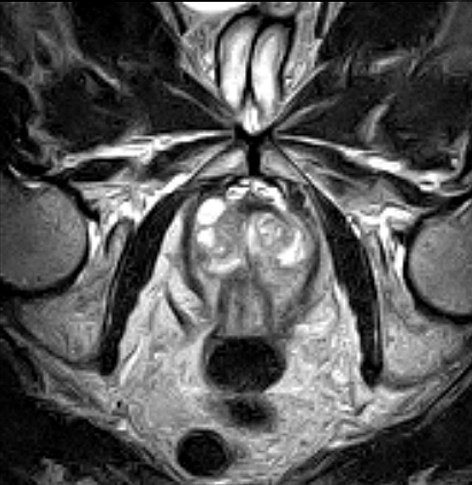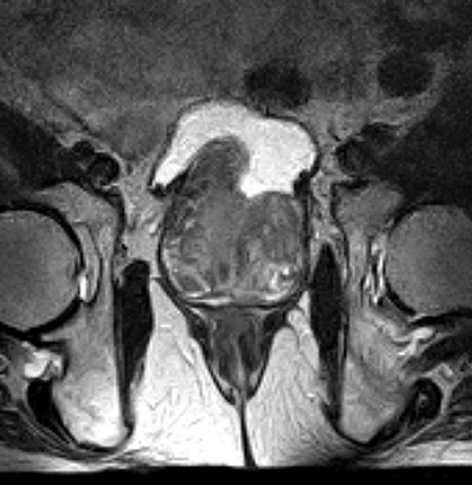Calm, dignified
experience
Medserena Prostate MRI Scan
From £735.00
MRI scan of the prostate gland; non-invasive procedure to help diagnose medical conditions relating to the prostate gland, price includes:
- Open and Upright MRI scan
- 50 minutes appointment
- Radiologist findings report
- Images provided via secure link to your email address at the end of the scan and available to NHS trusts via IEP on request
- Complimentary refreshments
Please wear metal free clothing and if possible, avoid wearing any jewellery. Alternatively, Medserena can provide you with a gown to change into for your scan. Scroll down for more prostate MRI scan information.
Superior healthcare service with every Private MRI scan
Little or no
waiting time
Largest MRI scan centres
Premium
refreshments
Watch TV while
scanning
Medical report included
About Prostate MRI Scans
The main purpose of a prostate MRI scan is to rule out prostate cancer, the most common cancer in men with 47,500 new cases diagnosed every year in the UK. One in eight men will develop it in their lifetime, mainly those aged over 50. A prostate MRI scan can also be used to measure benign enlargement of the prostate gland, which happens naturally as part of ageing but can cause bladder symptoms such as needing to get up at night to pass urine.
The prostate MRI scan is carried out with you sitting on a piece of equipment which views the prostate from underneath, giving a clear view of the prostate gland without the need to undress. It takes around one hour to complete and gives a detailed view of the prostate.
Because of the open nature of an upright scanner the experience is far less intimidating for people who suffer from claustrophobia.
MRI is a non-invasive procedure and is one of the best types of imaging for looking at glands and surrounding soft tissue structures. The gold standard for imaging of the prostate is on a 3T MRI scanner, as this can provide multiparametric imaging; however, if you are very anxious about spending 45 minutes to an hour inside a conventional tunnel scanner then an upright MRI scan is a great substitute.
What conditions can a prostate MRI scan detect?
The main purpose of a prostate MRI scan is to rule out or diagnose prostate cancer or benign prostatic hyperplasia.
- Prostate cancer: Unfortunately, prostate cancer doesn’t have any symptoms until a tumour is large enough to press on the urethra (the tube where urine passes out of the body). If you are having a prostate MRI scan this is most likely because you will have had a raised level of a protein called prostate specific antigen (PSA) in a blood test and your doctor has advised more investigations. Alternatively, you may have started to have symptoms such as urinary retention, poor urine flow, needing to pass urine at night, dribbling urine, and lower back pain. Raised PSA levels do not necessarily mean you have prostate cancer and biopsies may have to be done using a needle which can be uncomfortable and unnecessary if the result turns out to be negative, which is why an MRI scan can be a better first line investigation in certain circumstances.
Prostate cancer is mostly slow- growing but some types are aggressive and fast growing. Improvements in treatments and more PSA testing are thought to have contributed to the survival rate for prostate cancer, tripling from 25 per cent to 84 per cent in the past 40 years. The 10-year survival rate is now 78 per cent overall.[i]
- Benign prostatic hyperplasia: Around 40 per cent of men over 50 and 80 per cent over 80 have an enlarged prostate.[ii] As the prostate increases in size, it presses on the urethra and causes urinary symptoms. It is associated with hormone levels dropping as men age. Urinary symptoms, including a weak urine stream, a feeling of incomplete emptying of the bladder and a need to get up a couple of the times to go to the bathroom in the night, are common symptoms. Drug therapy can help improve flow and sometimes surgery to reduce the size of the prostate can help the symptoms.
Other benefits of a Medserena prostate MRI scan
Open MRI scanners are a stress-free alternative to using a conventional enclosed tunnel MRI scanner, providing comfort and reassurance for people who suffer from anxiety or claustrophobia. Sitting upright is more comfortable for patients and the open front means patients can speak to a friend or relative or watch television throughout as distraction.
Open MRI scans can also accommodate larger/ heavier patients who might have difficulty fitting comfortably into a conventional tunnel scanner, as they can take weights of up to 35 stone (226kg). However, suitability will depend on the patient’s build and the area of anatomy that needs to be scanned.
FAQs
The Upright MRI is truly open. There are no tunnels, no narrow tubes. The system is particularly quiet, the examination is comfortable and does not trigger feelings of being in a confined space. This means that the Upright MRI is particularly tolerated by patients who suffer from “claustrophobia”.
Because the system offers you an unrestricted view, you can watch TV or see DVD movies on a large screen during the scan. Wearing headphones – as with other MRI systems – is usually not necessary.
According to the current state of knowledge, there is no danger to the patient’s health as magnetic resonance imaging only uses magnetic fields and radio waves.
Metallic foreign bodies within the patient, such as fixed dental prosthesis, artificial joints or metal plates after treatment for a fracture do not usually pose any danger. However, it is important to clarify that the implants you use are MRI-compatible before the examination.
MRI (Magnetic Resonance Imaging) utilises a large magnet, radio waves and a computer to form images of your body. It is non-invasive, painless and does not use any ionising radiation.
Our truly open MRI can scan you in different positions. Through the utilisation of a specially designed MRI system we can offer weight-bearing scans – sitting or standing. The design of the system allows the patient to be positioned in different postures (e.g. flexion or extension) so that the patient may be examined in the position where they experience pain. The reason to do this is that some pathologies are underestimated or even not seen in a conventional supine MRI scan. The technique has value in many applications: e.g. spine, knees, hips, ankles. This has been proven in scientific studies and documented in peer reviewed publications.
In addition, it offers the possibility of performing an MRI scan on patients who could not otherwise tolerate the examination. This may include the claustrophobic patient, who benefits from the truly open nature of the equipment, and the severely kyphotic patient or emphysema sufferer who simply cannot lie down. It can also facilitate scanning of large patients who struggle to fit conventional ‘bore’ MRI scanners.
Of course, we have a comfortable waiting area but if you want them to stay in the scan room with you, they will also need to fill out a safety questionnaire. There is enough space for a companion. The person can even hold your hand and communicate with you during the examination. This is particularly beneficial when examining teenager.
This depends above all on which part of the body needs to be examined. In the Upright MRI, special examinations can be carried out in various body positions. The entire scan generally takes between 30 and 45 minutes. However, since you have the opportunity to watch TV or DVD, this time will go by much quicker.
Eat and drink normally and, unless your doctor tells you otherwise, please continue taking medications as normal. If you have any special needs (e.g. wheelchair access) please inform us when making the appointment.
Your appointment confirmation; referral letter/form; Medical Insurance details if applicable. We accept all major debit/credit cards.
We will provide a gown/clothing for you to wear when you are scanned. If you prefer to wear your own, please ensure that you wear or bring clothing without any metal fasteners, zips or under-wiring as these cannot be worn in the scan room. The changing room can be locked for safe storage of your possessions.
You will be able to walk into the scanner. It has no tunnel or bore. You will be able to hear us and talk with us during your scan if necessary-and we will be able to see you at all times. Due to its open nature, you will even be able to watch TV or a DVD whilst having the scan. Depending on which part of you is being scanned, you may be asked to sit or stand, and assume different postures (for example bending forward.) The radiographer may place a receiver “coil” around the relevant area of your body. You will need to remain very still while the acquisition is done in order to prevent blurring of the images. You will hear some tapping from the scanner but in general it is much quieter than many other MRI scanners.
You will not feel anything while having the scan. There is no pain or unusual feeling of any type and you will experience no after effects.
YES. There are some things that can prevent you from having an MRI scan. You will be asked to complete a safety questionnaire on arrival at the Centre which will cover the contra-indications-but if you are making an appointment and any of the factors below affect you, please discuss this with us in advance as it may save you a wasted trip.
Contra-indications can include:
- Pacemaker
- IUDs
- Surgical clips
- Pregnancy
- Metal fragments in the body
- Metal pins/plates/screws
- Joint replacements
- Metal objects in eyes
- Cochlear implants
- IVC filters
- Metal heart valves
- Penile implants
It is also important to tell us if you have any tattoos or piercings.
Watches, jewellery, coins, keys, cigarette lighters, penknives, credit cards. piercings, hairgrips, wigs, nicotine patches, and hearing aids must be removed.
Your scan will be reported by a Consultant Radiologist. It will normally be available in a couple of days unless needed urgently. The images and report will be sent to your referring practitioner. If you have a follow up appointment, please make us aware of the details so we can ensure the report and images are available in time.



